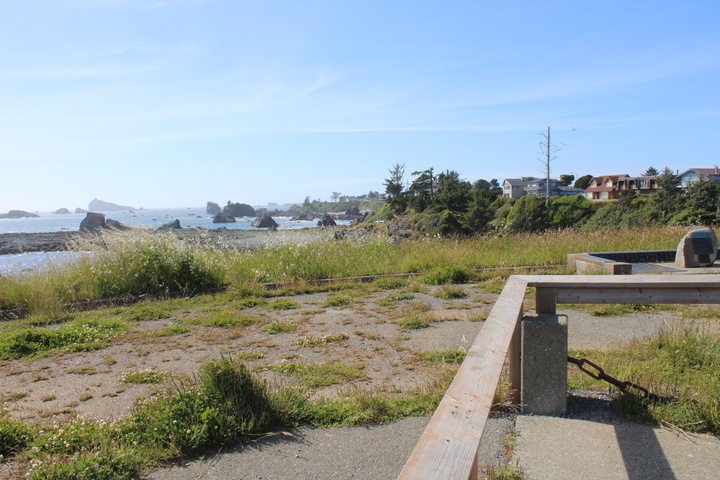Jessica Cejnar / Wednesday, March 17, 2021 @ 4:54 p.m. / Infrastructure, Local Government
Crescent City Council Seeks Tribal Support As It Seeks A Coastal Development Grant To Halt Bluff Erosion on Pebble Beach Drive

Crescent City hopes to get tribal support for a bank stabilization project along Pebble Beach Drive. Photo: Jessica Cejnar
With about 30 percent of the design finished, Crescent City will reach out to Elk Valley Ranchera and the Tolowa Dee-ni’ Nation as it prepares to submit Pebble Beach Drive bank stabilization project plans to the California Coastal Commission.
At the City Council’s request, staff will reach out to the Del Norte County Board of Supervisors, the Crescent City Harbor District Board of Commissioners as well as other community partners.
“I feel if we get both the the Tolowa Dee-ni’ Nation and Elk Valley Rancheria’s support it does help us in getting a permit for our preferred alternative,” Public Works Director Jon Olson told the Council on Monday.
The city will submit its Coastal Development Permit application to the Coastal Commission on April 15, Olson said.
Funded through emergency relief dollars from the Federal Highways Administration in the wake of a December 2016 storm, the Pebble Beach Drive Bank Stabilization Project seeks to halt bluff erosion on the scenic thoroughfare with a particular focus on the Brother Jonathan Lookout.
The City Council entered into a $1.1 million agreement with COWI North American Inc. in June 2020 to spearhead the project.
According to COWI engineer Jean Toiliez, after walking the site his engineers discovered four “failure modes” in the Brother Jonathan area including groundwater seepage, deep seated rotational slides that could lead to bluff failure and toe undercutting from wave and tidal action.
“We see an ongoing degradation around the bluff face around the Brother Jonathan Lookout,” Toiliez said. “Part of the bluff is weak and continued wave action keeps chewing at the bluff. Steep escarpments are developing. The same process is repeated along Taylor Beach and in the pavement, cracks are visible, indicating the presence of a rotational slide.”
In addition to obtaining a Coastal Development Permit, Crescent City also has to reach out to the California Regional Water Quality Control Board, the National Marine Fisheries Service and the California Department of Fish and Wildlife for approval on the project.
Since the entire bluff is a “one wetland,” Toiliez said the objective is to minimize the impact of the rare species at that site. He said the plans also strive to highlight the area’s historical significance as the site of the Brother Jonathan Memorial Cemetery that commemorates the 1865 shipwreck.
“Last but not least, the site has a very high cultural significance to the City of Crescent City’s tribal partners, the Tolowa Dee-ni’ Nation and Elk Valley Rancheria,” Toiliez said. “The team has participated in various exchanges, including a site visit, as well as follow-up communication with both tribes. We have received written feedback from the Tolowa Dee-ni’ Nation.”
To arrest bluff erosion in the area, Toiliez proposed a buried low-profile wall on the pocket beach north of the Brother Jonathan Lookout. This, he said, would remedy the ongoing rotational slides before they become a full slide.
Another low-profile, or buried, wall is proposed for the beach north of the Brother Jonathan Lookout, Taylor Beach. At Brother Jonathan Point, Toiliez proposed an external buttress, a rock flow protection, that would mimic the environment.
In addition to a pedestrian path running along Brother Jonathan Lookout, Toiliez said the plans also call for landscape improvements, including planted berms and another wall constructed of soldier piles and concrete leggings. This, he said, will stop further erosion and will protect Pebble Beach Drive’s integrity.
Another proposal is to install a cobble berm that would absorb wave action, reducing its energy and its impact to the bluff, Toiliez said.
“Working with partners (we plan) to plant native species, done with the input of resource agencies,” Toiliez said. “We believe that will boost the ecological value of the system. At the toe we want to place a system that blends into the natural landscape incorporating rocks so it blends into the existing configuration.”
The rock-based structures have an expected lifespan of 25 years, Toiliez said. The buttressing at Brother Jonathan Point will have an expected lifespan of 50 years, he said.
According to Toiliez, a major hurdle the city has to overcome when it comes to getting the permits to start the project, is establishing a clear need. This means assessing the project’s value to the community.
Olson, who had spoken with Coastal Commission staff, said they’re asking if shoring up Pebble Beach is a “real need” in the near term. This includes asking if the city is in danger of losing the road in three to five years, Olson said.
“One of the options presented by our coastal staff is, ‘What is the least invasive thing you can do and is retreat an option and you just allow Pebble Beach to fall into the ocean and then provide access opportunities somewhere else.’” Olson said. “‘Can you move back to Taylor Street? Can you move to some of the interior streets? Do you really need to have the Brother Jonathan (Lookout)? Is that an important feature for your community?’ The general impression I got when talking with Coastal staff was that it didn’t concern them very much. What we want to get from both our tribal partners and the community at large is, ‘Yes, this is really important.’”
Toiliez said his hope is that reaching out to other community partners will help educate Coastal Commission staff that Pebble Beach Drive is a place of public enjoyment, cultural significance and high economic value.
“What we want to do is get the support we need to provide a more holistic picture of the project and say this is truly an optimized project to manage bluff erosion in a responsible manner,” he said.
CLICK TO MANAGE